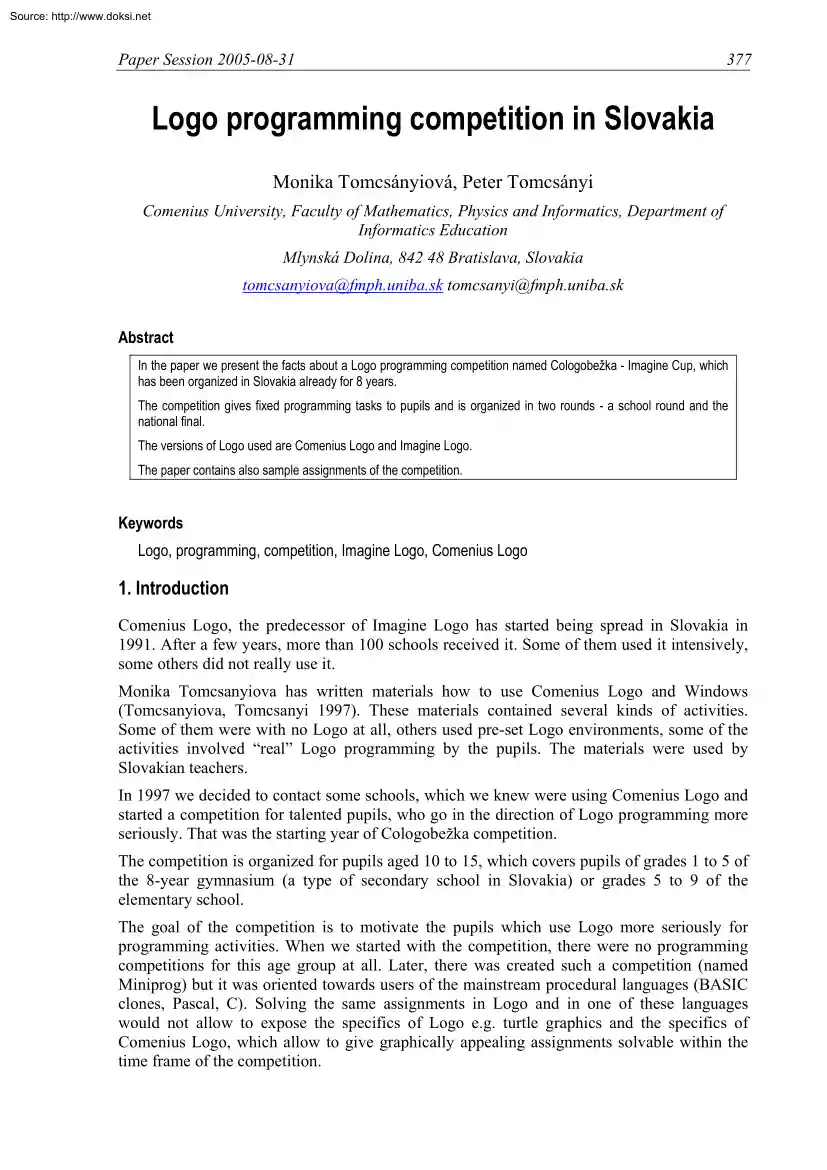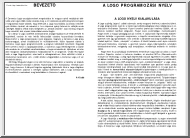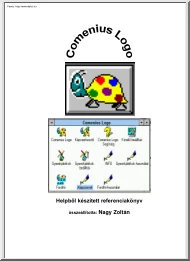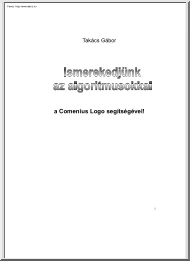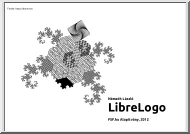Datasheet
Year, pagecount:2005, 6 page(s)
Language:English
Downloads:5
Uploaded:May 14, 2018
Size:617 KB
Institution:
-
Comments:
Comenius University
Attachment:-
Download in PDF:Please log in!
Comments
No comments yet. You can be the first!Most popular documents in this category
Content extract
Source: http://www.doksinet Paper Session 2005-08-31 377 Logo programming competition in Slovakia Monika Tomcsányiová, Peter Tomcsányi Comenius University, Faculty of Mathematics, Physics and Informatics, Department of Informatics Education Mlynská Dolina, 842 48 Bratislava, Slovakia tomcsanyiova@fmph.unibask tomcsanyi@fmphunibask Abstract In the paper we present the facts about a Logo programming competition named Cologobežka - Imagine Cup, which has been organized in Slovakia already for 8 years. The competition gives fixed programming tasks to pupils and is organized in two rounds - a school round and the national final. The versions of Logo used are Comenius Logo and Imagine Logo. The paper contains also sample assignments of the competition. Keywords Logo, programming, competition, Imagine Logo, Comenius Logo 1. Introduction Comenius Logo, the predecessor of Imagine Logo has started being spread in Slovakia in 1991. After a few years, more than 100 schools received it
Some of them used it intensively, some others did not really use it. Monika Tomcsanyiova has written materials how to use Comenius Logo and Windows (Tomcsanyiova, Tomcsanyi 1997). These materials contained several kinds of activities Some of them were with no Logo at all, others used pre-set Logo environments, some of the activities involved “real” Logo programming by the pupils. The materials were used by Slovakian teachers. In 1997 we decided to contact some schools, which we knew were using Comenius Logo and started a competition for talented pupils, who go in the direction of Logo programming more seriously. That was the starting year of Cologobežka competition The competition is organized for pupils aged 10 to 15, which covers pupils of grades 1 to 5 of the 8-year gymnasium (a type of secondary school in Slovakia) or grades 5 to 9 of the elementary school. The goal of the competition is to motivate the pupils which use Logo more seriously for programming activities. When we
started with the competition, there were no programming competitions for this age group at all. Later, there was created such a competition (named Miniprog) but it was oriented towards users of the mainstream procedural languages (BASIC clones, Pascal, C). Solving the same assignments in Logo and in one of these languages would not allow to expose the specifics of Logo e.g turtle graphics and the specifics of Comenius Logo, which allow to give graphically appealing assignments solvable within the time frame of the competition. Source: http://www.doksinet 378 Eurologo 2005, Warsaw When in 2001 also Imagine started to be spread in Slovakia, we allowed also Imagine programmers to participate. We did not create two categories, so some of the participants use Comenius Logo some others use Imagine. Their choice usually depends on what they use in the school. 2. Organization of the competition The competition is officially organized, supported and sponsored by the Department of
Informatics Education of Faculty of Mathematics, Physics and Informatics of Comenius University, Methodical and pedagogical centre in Bratislava, Slovak Society for Computer Science and Slovak Society of Electronics. The team of organizers is quite small and always include both of the authors of this paper. Additional 3 to 4 colleagues and students as well as one or two members of staff of the School Computing Centre in the town Piešťany help us to organize the National final round. The competition preparation starts in December. Schools can sign-in for the competition Some schools participate every year, some others participated just once or twice. The number of schools is quite stable about 20 in last years. It may seem too little, but if we take into consideration that using Logo is not obligatory and that the competitions aim is to appoint the students who take programming quite seriously, then we think that this is a good number. In every school there is a teacher who is
responsible for the competition. In spring, the school round of the competition is held. It must be organized by the schools on the same day The responsible teachers receive the assignments by e-mail and send pupils’ solutions also by email. In previous years we also used floppy disks and regular mail, but in the last years, that is not needed any more. The assignments of the school round must be solved at computers within 90 minutes. There are three assignments in the set In about one month the organizers (usually only Monika) evaluate pupils’ solutions and the results are announced on the Web. The best 15 pupils are selected to participate in the national final round, which takes place in June in the town of Piešťany in the School Computing Centre. The national final round has the same rules as the school rounds - there are 3 assignments, which must be solved at computers within 90 minutes. This takes place in the morning In the afternoon the jury evaluates the solutions while
the pupils have free time in the town. In latest two years we also organized a show of own Logo programs where the participants can show any Logo program, which they made and which they find to be interesting enough to show to others. In the evening the winners are announced. They are awarded by prizes sponsored by some of the organizing bodies and the organizers themselves. 3. The assignments In each round there are three assignments to solve. They are designed in such a way that even beginners should solve at least one of them so that they should not be disappointed by too high level of the assignments. However, on the other hand, they must be also challenging enough for the best participants and to allow the jury to decide who is the best one. In many cases the assignments have two levels - a simpler one and a more advanced one. This also helps the participants to complete at least a part of the assignment not to go home with nothing achieved. Source: http://www.doksinet Paper
Session 2005-08-31 379 In the following paragraphs we describe the types of assignments and give an example of each type. You can find more assignments translated to English in: http://user.edifmphunibask/tomcsanyiova/english/competionhtml 3.1 First assignment - Turtle geometry The first assignment is always oriented towards turtle geometry. It means that the solution is a program (usually of one or a few procedures) painting a defined picture. Some pictures are fixed, others are parameterised and some of them contain random parts. The Sun Draw the picture of the sun as you can see it in the picture above. Each of its rays consists of several squares. The size of their sides decreases by 3 steps The sun consists of several rays Implement a procedure Ray :MaxSize :n where MaxSize is the size of the biggest square in the ray and n is the number of squares which constitute the ray. Implement a procedure sun :Rays :MaxSize :n. The first input defines the number of rays the other two
inputs are given to each call of Ray. Implement the command Startup, which draws the sun with 9 rays each consisting of 7 squares and the bigest square side is 30 steps long. 3.2 Second assignment - an animation The second assignment is usually the easiest one and requires the pupils to create a kind of animation or a very simple demo or game-like program using the bitmap graphics capabilities of Comenius Logo and Imagine Logo. To solve this assignment usually means to create a few turtles, give them proper shapes and write a few lines of code to move and animate some of the turtles and/or to react on clicks or other mouse events. To help the pupils to manage this task within 90 minutes and not to disappoint programmers, who are not good in drawing pictures, the organizers provide them with graphics files to use in their solutions. Source: http://www.doksinet 380 Eurologo 2005, Warsaw Choose a game A programmer has created 4 nice games. He would like to put them together and sell
them as one set of four games. He needs to implement a starting screen, which would allow the user to choose one of the games to play. Help the programmer to implement it The starting screen consists of castle a picture with 4 gates. Simple version: When the user clicks onto a gate it starts to animate - it opens and closes and then stops animating. At most one gate is being animated in any moment When the user clicks on a gate, which is currently being animated then he enters that game, i.e the starting bitmap of that game is shown on the screen (and the rest will be programmed by somebody else). Advanced version: The gate starts to animate when the mouse cursor is placed over it (with no click). More than one gate can be animating in the same time if the used moves the mouse pointer quickly. When the user clicks a gate, which is being animated then it enters the chosen game in the same manner as described in the simpler version. Do not forget to add a startup procedure, which has to
show the castle with gates. The picture of the castle is in the file castle.bmp, the pictures of animated gates are in files dvere1.lgw, gate2lgw, gate3lgw, and gate4lgw The starting bitmaps of the four games are in files flowers.bmp, dotsbmp, mastermindbmp, and chessbmp 3.3 Third assignment - a game The third assignment is there for the most advanced young programmers. It requires them to program a complete simple game-like program. It is often a logical game or a table game The computer should only serve as the place where the user or users play the game (i.e the computer does not act as a player, but it may evaluate the game and check when one of the players won). Usually only a few pupils are able to complete this assignment and some others implement it only partly. So this assignment usually distinguishes the best pupils and gives a challenge serious enough not to lose motivation. The result of the assignment is a simple but playable game. Source: http://www.doksinet Paper
Session 2005-08-31 381 Dominoes You should know the traditional game of dominoes quite well. Your task will be to create a computer version of this game so that the computer is the place where two players can play the game. The desktop is divided into four parts. In the left yellow part there are the pieces not in the game yet. The green player puts his not used pieces aside in the upper part, the blue player puts his not used pieces at the bottom. The middle grey part is a game board to place the pieces. When the play starts, all 28 domino pieces appear in the yellow part showing their reverse so the players cannot see their content. After clicking on a piece, this one turns so that the player can see its content. Then the piece can be dragged around by the mouse The Space key on the keyboard turns the piece in one of its four possible orientations. Using all these manipulations the player can place the chosen piece either to the middle grey part or to its green or blue part of the
screen. The program does not try to evaluate if the piece was put on a correct place You can find the pictures of 28 pieces with their phases in the file dominoS.lgw – each piece has got four phases because it is possible to turn it into four positions. The reverse of the pieces is in the file reverse.lgw A game board is in the file dominobmp It is designed for full screen 800x600. 4. Statistics The following table summarizes the number of participating schools and pupils in the first round of the competition in each year: Year Schools Pupils 1997/98 5 26 1998/99 12 57 1999/2000 21 88 2000/01 20 176 2001/02 30 194 Source: http://www.doksinet 382 Eurologo 2005, Warsaw Year Schools Pupils 2002/03 27 140 2003/04 14 116 2004/05 17 132 As you can see from the number of participants the competition is not a mass one. The main reason is that Logo is not an obligatory subject. And also there are no official textbooks for the ages 10 to 15 yet. But this is
going to change - next school year a textbook will be published and it will be available for schools. It will be a Slovak translation of the book (Blaho, Kalas 2004) already published by Logotron in the UK. This should increase the interest of teachers towards introducing their pupils to Logo and it may also result in much more schools willing to participate in the competition. 5. Further plans We think that the competition in its current form is a good place for the pupils to compare their skills to the skills of others and that it gives them motivation to use Logo as a programming language to develop their problem solving skills. In the last two years we also added a presentation of Logo programs brought by participants of the national final. This was made not only for filling the time while the pupils are waiting for the jurys decision, but also to enable the pupils to show their skills to develop programs not based on fixed assignments. We have seen already a few very interesting
programs during these presentations. We do not try to evaluate and award these programs because it is hard to compare them and we also cannot assure that the programs were developed solely by the pupils themselves. We will continue organizing the presentations an accompanying event to the national final of the competition. 6. Conclusion By this paper we wanted to give information about our competition in Logo programming. We hope that it will go on and more and more schools in our country will take part in it. We hope that it may serve as an inspiration to colleagues in different countries who either organize a Logo competition already or just plan to do it, to find ideas to follow (or avoid). References Tomcsanyiova M and Tomcsanyi P (1997), Experimental IT edication for lower secondary school using Windows and Comenius Logo, M. Turcsanyi-Szabo (ed), Proceedings of the Sixth European Logo Conference, Budapest, 263-272 Blaho A and Kalas I (2004), Imagine Logo Primary Workbook,
Logotron, Cambridge English Web pages of the competition: http://user.edifmphunibask/tomcsanyiova/english/competionhtml Slovak Web pages of the competition: http://user.edifmphunibask/tomcsanyiova/cologobehtm
Some of them used it intensively, some others did not really use it. Monika Tomcsanyiova has written materials how to use Comenius Logo and Windows (Tomcsanyiova, Tomcsanyi 1997). These materials contained several kinds of activities Some of them were with no Logo at all, others used pre-set Logo environments, some of the activities involved “real” Logo programming by the pupils. The materials were used by Slovakian teachers. In 1997 we decided to contact some schools, which we knew were using Comenius Logo and started a competition for talented pupils, who go in the direction of Logo programming more seriously. That was the starting year of Cologobežka competition The competition is organized for pupils aged 10 to 15, which covers pupils of grades 1 to 5 of the 8-year gymnasium (a type of secondary school in Slovakia) or grades 5 to 9 of the elementary school. The goal of the competition is to motivate the pupils which use Logo more seriously for programming activities. When we
started with the competition, there were no programming competitions for this age group at all. Later, there was created such a competition (named Miniprog) but it was oriented towards users of the mainstream procedural languages (BASIC clones, Pascal, C). Solving the same assignments in Logo and in one of these languages would not allow to expose the specifics of Logo e.g turtle graphics and the specifics of Comenius Logo, which allow to give graphically appealing assignments solvable within the time frame of the competition. Source: http://www.doksinet 378 Eurologo 2005, Warsaw When in 2001 also Imagine started to be spread in Slovakia, we allowed also Imagine programmers to participate. We did not create two categories, so some of the participants use Comenius Logo some others use Imagine. Their choice usually depends on what they use in the school. 2. Organization of the competition The competition is officially organized, supported and sponsored by the Department of
Informatics Education of Faculty of Mathematics, Physics and Informatics of Comenius University, Methodical and pedagogical centre in Bratislava, Slovak Society for Computer Science and Slovak Society of Electronics. The team of organizers is quite small and always include both of the authors of this paper. Additional 3 to 4 colleagues and students as well as one or two members of staff of the School Computing Centre in the town Piešťany help us to organize the National final round. The competition preparation starts in December. Schools can sign-in for the competition Some schools participate every year, some others participated just once or twice. The number of schools is quite stable about 20 in last years. It may seem too little, but if we take into consideration that using Logo is not obligatory and that the competitions aim is to appoint the students who take programming quite seriously, then we think that this is a good number. In every school there is a teacher who is
responsible for the competition. In spring, the school round of the competition is held. It must be organized by the schools on the same day The responsible teachers receive the assignments by e-mail and send pupils’ solutions also by email. In previous years we also used floppy disks and regular mail, but in the last years, that is not needed any more. The assignments of the school round must be solved at computers within 90 minutes. There are three assignments in the set In about one month the organizers (usually only Monika) evaluate pupils’ solutions and the results are announced on the Web. The best 15 pupils are selected to participate in the national final round, which takes place in June in the town of Piešťany in the School Computing Centre. The national final round has the same rules as the school rounds - there are 3 assignments, which must be solved at computers within 90 minutes. This takes place in the morning In the afternoon the jury evaluates the solutions while
the pupils have free time in the town. In latest two years we also organized a show of own Logo programs where the participants can show any Logo program, which they made and which they find to be interesting enough to show to others. In the evening the winners are announced. They are awarded by prizes sponsored by some of the organizing bodies and the organizers themselves. 3. The assignments In each round there are three assignments to solve. They are designed in such a way that even beginners should solve at least one of them so that they should not be disappointed by too high level of the assignments. However, on the other hand, they must be also challenging enough for the best participants and to allow the jury to decide who is the best one. In many cases the assignments have two levels - a simpler one and a more advanced one. This also helps the participants to complete at least a part of the assignment not to go home with nothing achieved. Source: http://www.doksinet Paper
Session 2005-08-31 379 In the following paragraphs we describe the types of assignments and give an example of each type. You can find more assignments translated to English in: http://user.edifmphunibask/tomcsanyiova/english/competionhtml 3.1 First assignment - Turtle geometry The first assignment is always oriented towards turtle geometry. It means that the solution is a program (usually of one or a few procedures) painting a defined picture. Some pictures are fixed, others are parameterised and some of them contain random parts. The Sun Draw the picture of the sun as you can see it in the picture above. Each of its rays consists of several squares. The size of their sides decreases by 3 steps The sun consists of several rays Implement a procedure Ray :MaxSize :n where MaxSize is the size of the biggest square in the ray and n is the number of squares which constitute the ray. Implement a procedure sun :Rays :MaxSize :n. The first input defines the number of rays the other two
inputs are given to each call of Ray. Implement the command Startup, which draws the sun with 9 rays each consisting of 7 squares and the bigest square side is 30 steps long. 3.2 Second assignment - an animation The second assignment is usually the easiest one and requires the pupils to create a kind of animation or a very simple demo or game-like program using the bitmap graphics capabilities of Comenius Logo and Imagine Logo. To solve this assignment usually means to create a few turtles, give them proper shapes and write a few lines of code to move and animate some of the turtles and/or to react on clicks or other mouse events. To help the pupils to manage this task within 90 minutes and not to disappoint programmers, who are not good in drawing pictures, the organizers provide them with graphics files to use in their solutions. Source: http://www.doksinet 380 Eurologo 2005, Warsaw Choose a game A programmer has created 4 nice games. He would like to put them together and sell
them as one set of four games. He needs to implement a starting screen, which would allow the user to choose one of the games to play. Help the programmer to implement it The starting screen consists of castle a picture with 4 gates. Simple version: When the user clicks onto a gate it starts to animate - it opens and closes and then stops animating. At most one gate is being animated in any moment When the user clicks on a gate, which is currently being animated then he enters that game, i.e the starting bitmap of that game is shown on the screen (and the rest will be programmed by somebody else). Advanced version: The gate starts to animate when the mouse cursor is placed over it (with no click). More than one gate can be animating in the same time if the used moves the mouse pointer quickly. When the user clicks a gate, which is being animated then it enters the chosen game in the same manner as described in the simpler version. Do not forget to add a startup procedure, which has to
show the castle with gates. The picture of the castle is in the file castle.bmp, the pictures of animated gates are in files dvere1.lgw, gate2lgw, gate3lgw, and gate4lgw The starting bitmaps of the four games are in files flowers.bmp, dotsbmp, mastermindbmp, and chessbmp 3.3 Third assignment - a game The third assignment is there for the most advanced young programmers. It requires them to program a complete simple game-like program. It is often a logical game or a table game The computer should only serve as the place where the user or users play the game (i.e the computer does not act as a player, but it may evaluate the game and check when one of the players won). Usually only a few pupils are able to complete this assignment and some others implement it only partly. So this assignment usually distinguishes the best pupils and gives a challenge serious enough not to lose motivation. The result of the assignment is a simple but playable game. Source: http://www.doksinet Paper
Session 2005-08-31 381 Dominoes You should know the traditional game of dominoes quite well. Your task will be to create a computer version of this game so that the computer is the place where two players can play the game. The desktop is divided into four parts. In the left yellow part there are the pieces not in the game yet. The green player puts his not used pieces aside in the upper part, the blue player puts his not used pieces at the bottom. The middle grey part is a game board to place the pieces. When the play starts, all 28 domino pieces appear in the yellow part showing their reverse so the players cannot see their content. After clicking on a piece, this one turns so that the player can see its content. Then the piece can be dragged around by the mouse The Space key on the keyboard turns the piece in one of its four possible orientations. Using all these manipulations the player can place the chosen piece either to the middle grey part or to its green or blue part of the
screen. The program does not try to evaluate if the piece was put on a correct place You can find the pictures of 28 pieces with their phases in the file dominoS.lgw – each piece has got four phases because it is possible to turn it into four positions. The reverse of the pieces is in the file reverse.lgw A game board is in the file dominobmp It is designed for full screen 800x600. 4. Statistics The following table summarizes the number of participating schools and pupils in the first round of the competition in each year: Year Schools Pupils 1997/98 5 26 1998/99 12 57 1999/2000 21 88 2000/01 20 176 2001/02 30 194 Source: http://www.doksinet 382 Eurologo 2005, Warsaw Year Schools Pupils 2002/03 27 140 2003/04 14 116 2004/05 17 132 As you can see from the number of participants the competition is not a mass one. The main reason is that Logo is not an obligatory subject. And also there are no official textbooks for the ages 10 to 15 yet. But this is
going to change - next school year a textbook will be published and it will be available for schools. It will be a Slovak translation of the book (Blaho, Kalas 2004) already published by Logotron in the UK. This should increase the interest of teachers towards introducing their pupils to Logo and it may also result in much more schools willing to participate in the competition. 5. Further plans We think that the competition in its current form is a good place for the pupils to compare their skills to the skills of others and that it gives them motivation to use Logo as a programming language to develop their problem solving skills. In the last two years we also added a presentation of Logo programs brought by participants of the national final. This was made not only for filling the time while the pupils are waiting for the jurys decision, but also to enable the pupils to show their skills to develop programs not based on fixed assignments. We have seen already a few very interesting
programs during these presentations. We do not try to evaluate and award these programs because it is hard to compare them and we also cannot assure that the programs were developed solely by the pupils themselves. We will continue organizing the presentations an accompanying event to the national final of the competition. 6. Conclusion By this paper we wanted to give information about our competition in Logo programming. We hope that it will go on and more and more schools in our country will take part in it. We hope that it may serve as an inspiration to colleagues in different countries who either organize a Logo competition already or just plan to do it, to find ideas to follow (or avoid). References Tomcsanyiova M and Tomcsanyi P (1997), Experimental IT edication for lower secondary school using Windows and Comenius Logo, M. Turcsanyi-Szabo (ed), Proceedings of the Sixth European Logo Conference, Budapest, 263-272 Blaho A and Kalas I (2004), Imagine Logo Primary Workbook,
Logotron, Cambridge English Web pages of the competition: http://user.edifmphunibask/tomcsanyiova/english/competionhtml Slovak Web pages of the competition: http://user.edifmphunibask/tomcsanyiova/cologobehtm
